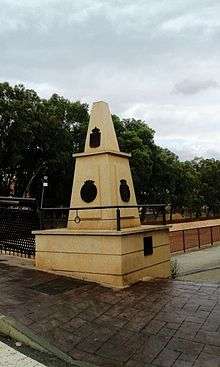Fuente Álamo de Murcia
| Fuente Álamo de Murcia | |||
|---|---|---|---|
| Municipality | |||
|
Fuente Álamo | |||
| |||
| Motto: Muy Noble y Muy Leal Villa | |||
 Fuente Álamo de Murcia Location in Spain | |||
| Coordinates: 37°43′N 1°8′W / 37.717°N 1.133°WCoordinates: 37°43′N 1°8′W / 37.717°N 1.133°W | |||
| Country |
| ||
| Autonomous community |
| ||
| Province | Murcia | ||
| Comarca | Campo de Cartagena | ||
| Judicial district | Cartagena | ||
| Founded | 15th century, from 1700 Villazgo | ||
| Government | |||
| • Mayor | María Antonia Conesa Legaz (2003) (PP) | ||
| Area | |||
| • Total | 273 km2 (105 sq mi) | ||
| Elevation | 127 m (417 ft) | ||
| Highest elevation | 1,062 m (3,484 ft) | ||
| Lowest elevation | 82 m (269 ft) | ||
| Population (2009) | |||
| • Total | 14,876 | ||
| • Density | 54/km2 (140/sq mi) | ||
| Demonym(s) | Fuentealameros | ||
| Time zone | CET (UTC+1) | ||
| • Summer (DST) | CEST (UTC+2) | ||
| Postal code | 30320 | ||
| Website | Official website | ||
Fuente Álamo de Murcia is a town and municipality in the Region of Murcia, southern Spain. It is situated 22 km northwest of Cartagena and 35 km south west of Murcia. The town lies in the basin of the Mar Menor surrounded by the mountains of Algarrobo, Los Gómez, Los Victorias and the Carrascoy.
The water from these mountains flows down into the Rambla de Fuente Álamo and then onto the Mar Menor. The highest point in the region is the "Eagles Rock" at 1,066m, situated in the Carrascoy mountains.
The town is known locally as Fuente Álamo (without using "de Murcia").
Climate
The climate of Fuente Álamo is best described as typical Mediterranean.[1] The actual classification is "Mediterranean semi-arid subtropical climate". The average yearly temperature is 18.4 °C, reaching highs of around 40 °C in July and August and dropping as low as 4 °C in December and January.
History


The town can trace its history back to 1520,[2] although there was activity in and around the site of the town several years prior to this date. The area was used for Transhumance by the shepherds and goat herders from La Mancha and there is a village and area named La Manchica (little La Mancha) to the south of Fuente Álamo.
In 1463 the area was referred to as "La fuente del alamo" in a dispute over who actually owned the land between the peoples of Cartagena and
In 1500 the council of Lorca, in an effort to assert its authority, started to allocate small sections of land to the population for the use of cultivation. The area was controlled by the "Three Councils" of Murcia, Lorca and Cartagena.
Permission was sought to build the first church in 1545.
On 5 July 1700 Fuente Álamo was Granted authority from King Charles II to exist as an independent township and 20 July that year elected its first mayor Gregorio Reyllo Hernández. The three councils, because each had a vested interest in controlling Fuente Álamo objected to this decree of independence and on 1 April 1702 King Felipe V rescinded the privilege of Fuente Álamo to exist independently. The title of mayor was then given on a yearly basis to a citizen of the three councils on a rotation basis. This situation was to exist until 1820 when full independence was restored.
During the latter part of the 18th century and the beginning of the 19th century the town declined due to the pollution of its water source. Some 3000 residents left and settled in the surrounding villages, and by 1822 only 9 houses were occupied in the town.
Napoleon's troops occupy the town in August 1823.
In 1939 shortly before the end of the civil war, Republican forces sank the troop carrier Castillo de Olite as it was leaving the port of Cartagena. Of the 2112 people on board 1476 were killed, 342 were injured and 294 were taken prisoner. The captured were transferred to Fuente Álamo where they were imprisoned. In 1966, in recognition of the services given by the people of the town, General Francisco Franco awarded Fuente Álamo with the title "Muy Noble y Muy Leal Villa" (Most noble and most loyal town).
Today the town is experiencing a rapid period of growth, both economically and demographically.
Main sights
- Parish church of San Agustín (16th century)
- Hermitage of San Roque
- Aljibón de Corverica
- Puente Viejo ("Old Bridge")
Demographics
The population of the municipality was in steady decline from 1950 until 2001 when it experienced a rapid growth due to foreigners taking up residence in the area. In the Murcia region as a whole in 2008 non Spanish residents account for 18.25% of the population.
Twin towns
 Ouveillan, France
Ouveillan, France


.svg.png)